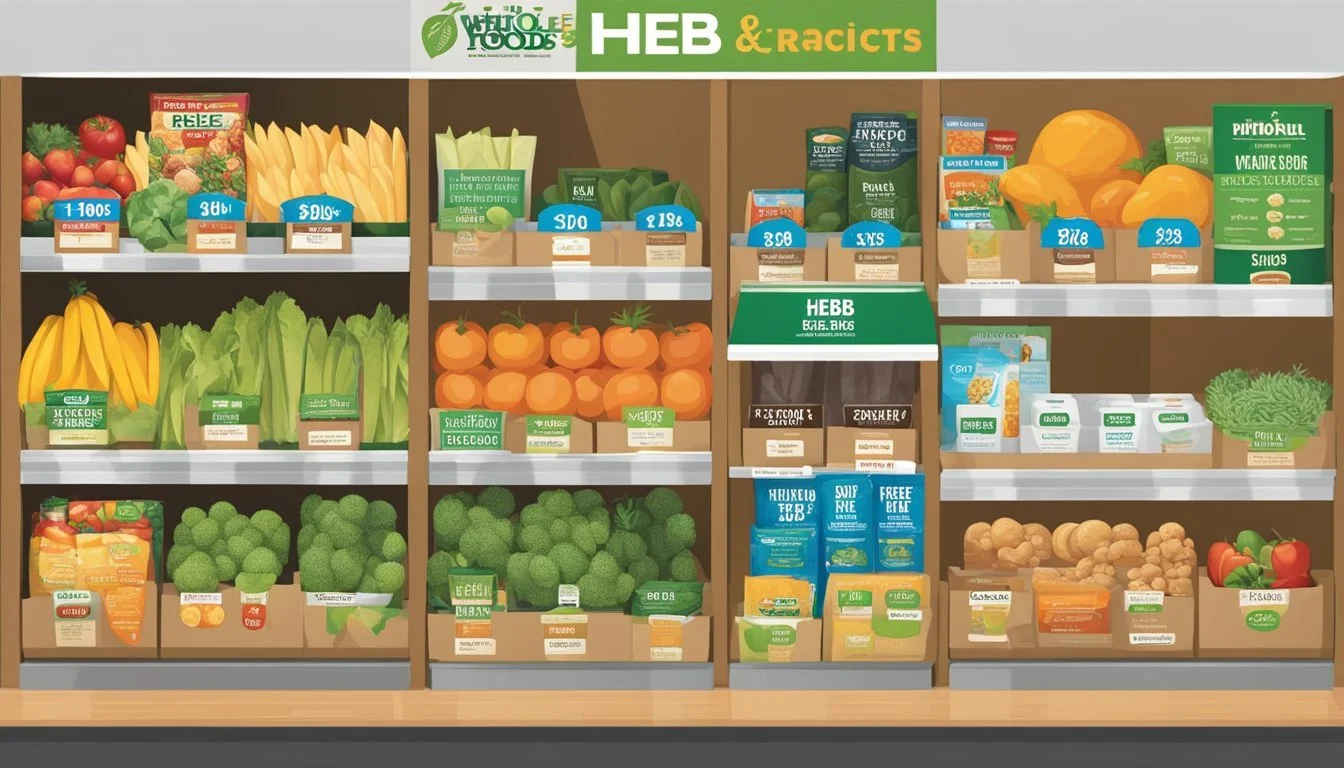Is Whole Foods Cheaper Than H-E-B?
Comparing Grocery Pricing
Part of Our Grocery Store Guide with Details on Whole Foods Market Prices and H-E-B Prices
When comparing grocery store prices, Whole Foods and H-E-B are frequently analyzed side by side, especially in Texas, where shoppers are keen to discern the best value for their grocery budget. H-E-B, a supermarket chain with its roots deep in the heart of Texas, is known for its competitive pricing and a strong regional presence. Whole Foods, on the other hand, has cultivated a reputation of being a pricier option, with its focus on organic and high-quality products.
Recent price comparisons point towards H-E-B generally offering lower prices on many comparable organic products than Whole Foods. Not only do organic items tend to be more affordable at H-E-B, but even other store items like beverages and snack bars are found to be less expensive. However, the price gap between Whole Foods and some of its competitors has been narrowing down; this is potentially attributed to strategic changes made after its acquisition by Amazon, aiming to shed the image of Whole Foods being considerably over-priced.
Every grocery store has its own strengths, and for some consumers, the choice between Whole Foods and H-E-B might come down to more than just price. Whole Foods is often lauded for its quality and variety, particularly in the realm of organic produce, whereas H-E-B is celebrated for its value and local product offerings. These elements contribute to the dynamic grocery shopping experience in Texas, leaving consumers with options that cater to different preferences and priorities.
Price Comparison Overview
When consumers choose where to shop for groceries, price is a paramount consideration. They often weigh the cost of items at upscale chains like Whole Foods against more traditional grocers such as H-E-B.
General Pricing Strategies
Whole Foods is known for its quality, organic products, and sustainable practices, which is often reflected in its pricing. Historically, Whole Foods has been viewed as the more expensive option. However, recent analyses suggest that the price gap between Whole Foods and H-E-B—a Texas-based grocer known for competitive prices and localized product selections—has narrowed. Whole Foods' produce has been reported to be only 7% more cost-effective than that of Kroger, indicating that Whole Foods might be more affordable than traditionally perceived, especially in the organic segment.
Discount and Savings Programs
Both grocery chains offer various discount programs designed to provide value to their customers. Whole Foods partners with Amazon to offer savings to Amazon Prime members, including special discounts on select items and an additional 10% off sale items. Conversely, H-E-B provides shoppers with savings through digital coupons, in-store promotions, and its H-E-B Savings card. Both strategies aim to mitigate high prices and attract budget-conscious customers.
Product Quality and Selection
When comparing Whole Foods and H-E-B, a distinct difference is evident in their selection of organic products, quality of meat and produce, and range of specialty dietary options.
Organic Product Offerings
Whole Foods has long established itself as a leader in organic products, offering a wide array of organic groceries and being recognized for its commitment to quality. Customers can find a comprehensive selection of organic fruits, vegetables, dairy products, and packaged goods. H-E-B, while slightly more economical, also provides a range of organic options, giving shoppers access to organic varieties at a relatively lower cost.
Meat and Produce Comparison
Both Whole Foods and H-E-B take pride in their meat and produce, with each asserting their own standards for quality. Whole Foods often touts its organic and responsibly sourced meat selections, yet at a higher price point. H-E-B, in contrast, offers competitive prices on meat, often sourcing local products to ensure freshness and support for local suppliers. As for produce, Whole Foods sometimes has higher prices, but it targets consumers seeking specifically organic produce. H-E-B competes with a focus on cost savings but does not compromise on delivering quality produce.
Specialty Dietary Options
Shoppers with specific dietary needs, such as gluten-free or plant-based diets, are well catered to at both supermarkets. Whole Foods holds an extensive range of gluten-free and plant-based options, including exclusive brands and specialty products often considered premium. H-E-B also accommodates various dietary preferences and includes an expanding selection of such alternatives, balancing between diversity and affordability. This commitment to specialty dietary options reflects both stores' dedication to address the diverse preferences of their customers.
Store Brands and Private Labels
When comparing Whole Foods and H-E-B in terms of cost efficiency, store brands and private labels play a significant role. Both retailers offer their exclusive brands, with Whole Foods showcasing their 365 brand and H-E-B featuring its Central Market and H-E-B brand products. Private labels, such as Central Market, offer consumers a range of gourmet and organic options, often paralleling higher-end brand names in quality.
Availability and Affordability
Whole Foods: Known for its 365 brand which caters to the organic and health-conscious consumer.
H-E-B: Offers a versatile selection through its H-E-B brand, and the Central Market line targets a more premium niche.
Quality and Perception
Recent shifts in consumer behavior suggest that private labels are shedding their image of inferior quality. Shoppers are finding that these labels often match or exceed the quality of national brands. The success of private labels like Central Market demonstrates the appeal of these products.
Local Favorites
H-E-B has capitalized on the Texan identity by partnering with local favorite Whataburger to offer branded condiments, further cementing its reputation for quality and regional pride. This association with well-known brands enhances the perception of H-E-B's store brand offerings.
In summary, private labels such as those offered by Whole Foods and H-E-B provide customers with a cost-effective alternative to national brands without compromising on quality. The growth and consumer acceptance of store brands, as evidenced by H-E-B's Central Market and Whataburger partnership, reveal their significant place in the contemporary grocery landscape.
Geographical Presence and Convenience
When considering grocery shopping in Texas, one must look at the parameters of store availability and the overall customer experience. These two facets greatly influence a shopper's choice between Whole Foods and H-E-B.
Store Locations in Texas
Whole Foods originated in Austin, Texas, and maintains a strong presence in the state with multiple stores, particularly in urban areas. In contrast, H-E-B has a broader reach across Texas, operating a large network of stores. The sheer number of H-E-B locations increases the brand's geographical convenience for a majority of Texans.
Austin: Known for its vibrant outdoor culture, Austin hosts both Whole Foods and H-E-B stores, with Whole Foods having its flagship store in the city.
State-Wide: While Whole Foods has a significant urban footprint, H-E-B's stores often serve both urban and smaller communities, making it a more accessible option for many residents.
Shopping Experience
Shoppers at both Whole Foods and H-E-B are treated to well-organized and high-quality environments, but the shopping experience diverges in focus:
Whole Foods: Emphasizes an upscale shopping ambiance and generally caters to customers seeking organic and high-end products.
H-E-B: Offers a tailored experience that celebrates Texan culture and includes a wide range of everyday products, incorporating elements of outdoor Texan life into its store design and product selection.
Both grocery chains aim to offer convenience, but H-E-B's extensive presence in Texas and its focus on local culture give it an edge in terms of geographical convenience and shopping experience familiarity for Texans.
Impact of Parent Companies
The ownership of Whole Foods by Amazon and the independent operation of H-E-B significantly influence their pricing and market strategies. The distinct operational models and parent company resources offer different competitive advantages to each.
Amazon's Influence on Whole Foods
Since Amazon acquired Whole Foods in 2017, it has implemented changes aimed at reducing prices and integrating its e-commerce platform with the grocery chain's operations. Amazon has leveraged its technological prowess to streamline Whole Foods’ inventory and supply chain management, which potentially lowers operating costs. It also introduced benefits for Prime members, such as special discounts and delivery options, which encourage cross-platform loyalty and increase sales volume.
H-E-B's Market Strategies
H-E-B operates independently of a larger corporate parent, which allows for agile and localized decision-making. This flexibility enables H-E-B to respond quickly to market changes and consumer preferences. It deploys strategic pricing on key items and offers a range of products that appeal to Texas consumers, such as local brands and their in-house products, frequently outpacing competitors like Walmart in regional market share. H-E-B maintains a robust presence in its Texas strongholds, which contributes to its ability to keep prices competitive.
Customer Shopping Behaviors
Customers today are highly intentional when it comes to shopping for groceries, with a primary focus on budget and value for money. They are not just looking for quality grocery items but also means of saving money. In this landscape, comparing Whole Foods and H-E-B is pertinent due to their differing price points and customer perceptions.
Brand Loyalty vs. Price Sensitivity: Consumers often juggle brand loyalty with price sensitivity. While Whole Foods is perceived as offering quality and organic products, H-E-B is often seen as providing more cost-effective options without a significant compromise on quality.
Organic Products: Many shoppers prioritize organic groceries but are also conscious of their budgets. When it comes to organic products, H-E-B frequently offers lower prices compared to Whole Foods.
Shopping Frequency:
Whole Foods customers tend to shop less frequently but purchase premium, organic, and niche market items.
H-E-B shoppers typically look for budget-friendly deals, visiting the store with higher frequency to take advantage of discounts and wider product variety.
List of Considerations:
Price Comparisons: Cost-conscious customers may prefer H-E-B for everyday grocery items.
Quality Expectations: Shoppers seeking specialized organic and health-focused groceries might lean towards Whole Foods despite higher costs.
Bulk Purchases: Buying in bulk is a common strategy for budget shoppers, and H-E-B offers competitive pricing for such purchases.
Retail trends show that the choice between Whole Foods and H-E-B can largely depend on individual priorities regarding the balance of cost-saving and purchasing premium grocery products.
Comparison with Other Retailers
In evaluating the cost of groceries at Whole Foods relative to H-E-B, it's crucial to also consider how these stores position themselves against national chains and local markets. Price trends indicate a competitive edge for H-E-B, especially for organic products.
Against National Chains
National chains like Walmart and Costco are recognized for their low pricing strategies. Walmart, for instance, often undercuts competitors’ prices, making it a go-to for budget-conscious shoppers. Similarly, Costco appeals to consumers looking for bulk purchases, which can translate to savings on a per-unit basis.
When comparing to premium grocery chains such as Whole Foods, these national retailers offer a broader variety of goods at more accessible price points. Aldi and Grocery Outlet also emerge as strong contenders in the affordability arena, consistently offering lower prices that appeal to a wide customer base.
Trader Joe’s, known for its unique variety and private label products, remains a popular choice for consumers looking for quality at moderate prices. On the other hand, Sprouts Farmers Market caters to the health-conscious shopper with a focus on fresh produce and health foods, often at a competitive price point, although typically higher than conventional chains like Walmart and Aldi.
Local Market Competition
Within local markets, H-E-B is a dominant force in Texas and competes effectively by offering lower prices on many items compared to Whole Foods. It strikes a balance between quality and affordability that resonates with local consumers. In contrast, Whole Foods has long been perceived as a pricier option, though recent reports suggest Whole Foods’ prices on certain items, like organic produce, have become more competitive.
Central Market, an upscale brand of H-E-B, also provides a specialty shopping experience, seemingly in direct competition with Whole Foods’ target market. Both stores offer a range of high-end goods, but H-E-B’s Central Market often does so at a lower price point.
In regions where Publix operates, especially in the Southeast, its commitment to customer service and a clean shopping environment have made it a favorite. Prices at Publix can be higher than Walmart but often align with or are slightly below Whole Foods, especially on store-brand items. Kroger, another significant player, generally offers prices that undercut Whole Foods, which has been narrowing the gap according to some price comparison studies.
Safeway and Target, with their own strategies focused on a mix of competitively priced generics and brand names, round out the landscape of retailers that Whole Foods competes with. Safeway provides a traditional grocery experience, often at a lower price point than Whole Foods, while Target combines general merchandise with a growing grocery selection.
Additional Services and Products
Whole Foods and H-E-B offer a variety of services and products that extend beyond just groceries. Customers can expect different conveniences that enhance the shopping experience, such as online grocery shopping options and a selection of non-grocery items.
Grocery Shop Online
Whole Foods Market, backed by Amazon, offers a robust online grocery shopping experience. Customers can order fresh produce, meats, and pantry staples for delivery or in-store pickup. One standout is their selection of prepared foods, which caters to individuals seeking quick and healthy meal options without the hassle of cooking.
H-E-B, on the other hand, boasts a competitive online service. Shoppers can purchase their groceries online and pick them up at the store or request delivery. Their website is user-friendly and offers a wide range of products including their exclusive H-E-B brand items and prepared foods. They often feature prominent deals and savings that are enticing for online shoppers.
Non-Grocery Items
Both stores extend their offerings to non-grocery items, though their selections vary.
Whole Foods:
Clothing: A limited selection of sustainable clothing.
Charmin: Does not typically carry traditional brands like Charmin but offers eco-friendly alternatives.
H-E-B:
Clothing: Offers a range of clothing options, including casual wear and seasonal items.
Charmin: Stocks a wide variety of household brands, including Charmin toilet paper.
By catering to convenience and versatility, these stores strive to meet all of their customers' shopping needs, both food and non-food related.
Branding and Consumer Perception
Whole Foods and H-E-B both command distinctive presences in the grocery market, with each appealing to specific sectors of consumer bases through their branding strategies. Whole Foods, often associated with higher-end, organic products and an emphasis on quality, caters to an eco-conscious and health-oriented demographic. Its consumers generally perceive the brand as a provider of premium goods, albeit at a higher price point.
On the other hand, H-E-B, a grocery chain with deep roots in Texas, is perceived as a more accessible option. It provides a wide range of products, including organic options, without the premium branding of Whole Foods. The H-E-B brand is synonymous with value and community trust, offering competitive prices while still maintaining a standard of quality that keeps customers loyal.
Consumer Preferences:
Whole Foods: Prefers organic and high-quality products.
H-E-B: Prefers value, accessibility, and local trust.
The distinction in branding also affects how consumers manage their shopping preferences. When considering organic products, consumers might lean towards Whole Foods for its reputation in this niche. Conversely, those seeking overall value while still having access to a range of organic and quality options might favor H-E-B.
It's crucial to note that while Whole Foods' reputation for quality frequently justifies its higher prices in the minds of its consumers, the H-E-B brand leverages its customer experience and localized approach to foster a different kind of loyalty, one not solely predicated on the organic label or perceived prestige but on a balanced offering of cost-effectiveness and quality.







